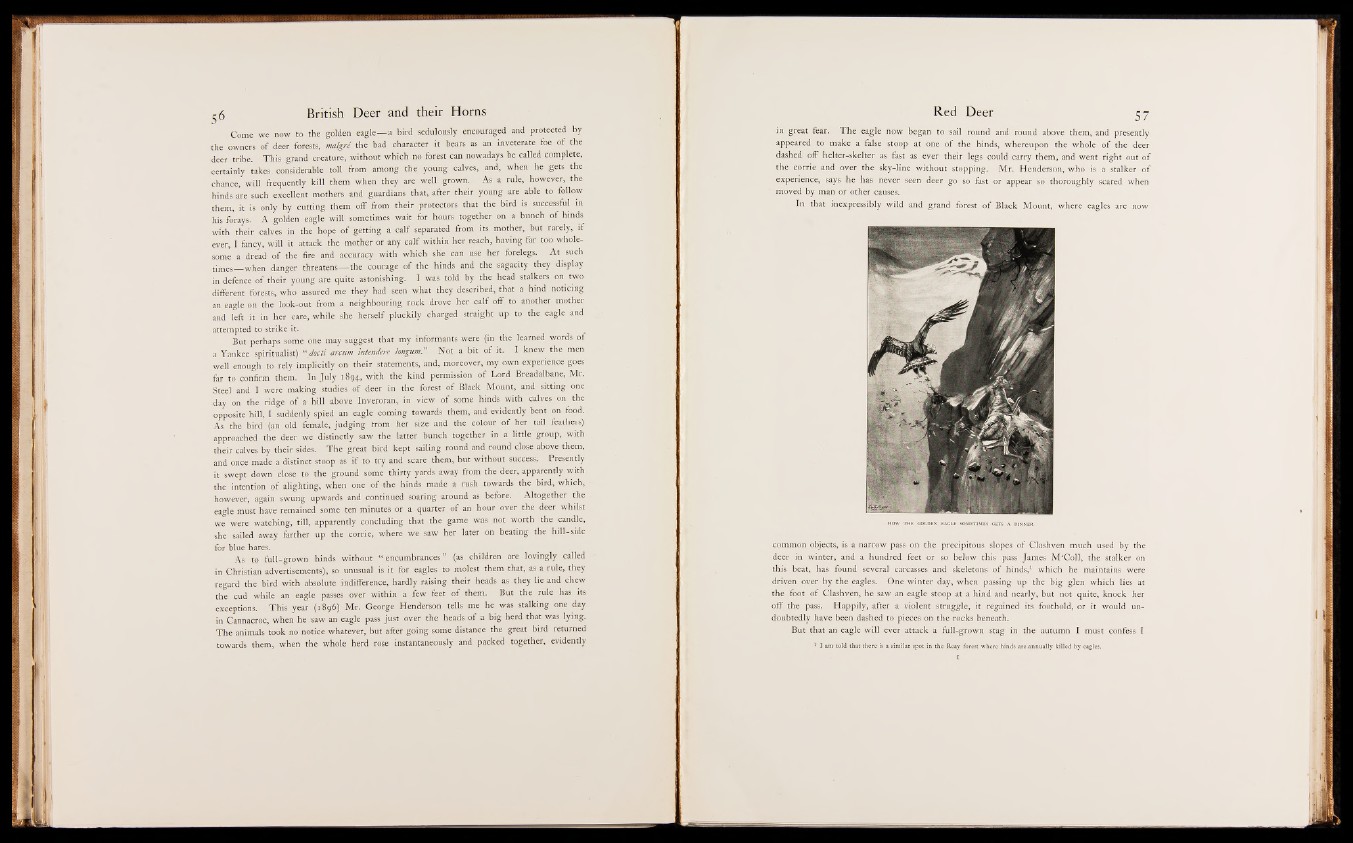
Come we now to the golden eagle— a bird sedulously encouraged an « r e te c te d by
the owners of deer forests, malgri the bad character it bears as an inveterate foe o f the
deer tribe. This grand creature, without which ijpfSbrest can nowadays be called complete,
certainly takes, considerable toll from among the young calves, and, when he .gets the
chance, will frequently kill them when they are well grown. As a rule, however, the
hinds are such excellent mothers and guardians that, after their young are able to follow
them, it is only by cutting them off from their protectors that the bird is spKdssful in
his forays. A golden eagle will sometimes wait for hours together on a bunch o f hinds
with their calves in the hope h| getting a calf separate»rom its mother, but rarely, i f
ever, I fancy, will it attack the mother: % any calf within her reach, having far too whole-
l im e a dread o f the fire and accuracy with which she can use h e r j|te ie g s . A t such
times— when danger threatensBthe courage-»the,»hinds and the sagacity they display
in defence of their young are quiteTastbmshing. I was told by the head stalkers or. two
different forests, who assured me they had: .s>Su what they described, that a hind noticing
an eagle on the- lcMb-out from a neighbouring rock drove her calf off, to another mother
and left it in her care, while she herself pluckily charged straight up to the eagle and
attempted to strike it.
But perhaps some one may suggest that my informants were (in the learned words o f
a Yankee spiritualist) “ docti arcum intendere longum.” Not a bit o f it. I knew the men
well enough to rely implicitly on their statements, and, moreover, my own experience goes
far to confirm them. In July 1894, with the kind permission o f Lord Breadalbane, Mr.
Steel and I were making studies of deer in the forest o f Black Mount, and sitting one
day on the ridge of a hill above Inveroran, in view o f some hinds with calves -on the
opposite hill, I suddenly spied an eagle coming towards them, and evidently b en l .on food.
As the bird (an old female, judging from her. size and the colour o f her tail feathers)
approached the deer we distinctly saw the latter bunch together in a little "group, with
their calves by their sides. The great bird kept sailing round and round close above them,
and once made a distinct stoop as i f to try and scare them, but without success. Presently
it swept down close to the ground some thirty yards away from the deer, apparently with
the intention o f alighting, when one o f the hinds made a rush towards the bird, which,
however, again swung upwards and continued soaring around as before. Altogether the
eagle must have remained some ten minutes or a quarter o f an hour over the deer whilst
we were watching, till, apparently concluding that the game was not worth the candle,
she sailed away farther up the corrie, where we saw her later on beating the hill-side
for blue hares.
As to full-grown hinds without “ encumbrances’’ (as children are lovingly called
in Christian advertisements), so unusual is it for eagles to molest them that, as a rule, they
regard the bird with absolute indifference, hardly raising their heads as they lie and chew
the cud while an eagle passes over within a few feet o f them. But the rule has its
exceptions. This year (1896) Mr. George Henderson tells me he was stalking one day
in Cannacroc, when he saw an eagle pass, just over the heads o f a big herd that was lying.
The animals took no notice whatever, but after going some distance the great bird returned
towards them, when the whole herd rose instantaneously and packed together, evidently
in great fear. The eagle now began to sail round and round above them, and presently
appeared to make a false stoop at one o f the hinds, whereupon the whole o f the deer
dashed off helter-skelter as fast as ever their legs could carry them, and went right out of
the corrie and over the sky-line without stopping. Mr. Henderson, who is a stalker of
experience, says he has never seen deer go so fast or appear so thoroughly scared when
moved by man or other causes.
In that inexpressibly wild and grand forest o f Black Mount, where eagles are now
common objects, is a narrow pass on the precipitous slopes of Clashven much used by the
deer in winter, and a hundred feet or so below this pass James M ‘Coll, the stalker on
this beat, has found several carcasses and skeletons o f hinds,1 which he maintains were
driven over by the eagles. One winter day, when passing up the big glen which lies at
the foot o f Clashven, he saw an eagle stoop at a hind and nearly, but not quite, knock her
off the pass. Happily, after a violent struggle, it regained its foothold, or it would undoubtedly
have been dashed to pieces on the rocks beneath.
But that an eagle will ever attack a full-grown stag in the autumn I must confess I
1 I am told that there is a similar spot in the Reay forest where hinds are annually killed by eagles.